Physical Address
304 North Cardinal St.
Dorchester Center, MA 02124
* Acknowledgement: This study was supported by a grant from the Fetal Medicine Foundation (Charity No: 1037116).
Aneuploidies are major causes of perinatal death and childhood disability. Consequently, the detection of chromosomal disorders constitutes the most frequent indication for invasive prenatal diagnosis. However, invasive testing, by amniocentesis or chorionic villus sampling (CVS), is associated with a risk of miscarriage and therefore these tests are carried out only in pregnancies considered to be at high-risk for aneuploidies.
In the 1970s, the main method of screening for aneuploidies was by maternal age and in the 1980s by maternal serum biochemistry and detailed ultrasonographic examination in the second trimester. In the 1990s the emphasis shifted to the first trimester when it was realized that the great majority of fetuses with major aneuploidies can be identified by a combination of maternal age, fetal nuchal translucency (NT) thickness and maternal serum free ß-human chorionic gonadotrophin (β-hCG), and pregnancy-associated plasma protein-A (PAPP-A). In the last 10 years several additional first-trimester sonographic markers have been described which improve the detection rate of aneuploidies and reduce the false-positive rate. The performance of the different methods of screening for trisomy 21 are summarized in Table 2-1 .
| Method of Screening | Detection Rate (%) |
False-Positive Rate (%) |
|---|---|---|
| Maternal age (MA) | 30 | 5 |
| First Trimester | ||
| MA + fetal nuchal translucency (NT) | 75–80 | 5 |
| MA + serum free β-hCG and PAPP-A | 60–70 | 5 |
| MA + NT + free β-hCG and PAPP-A (combined test) | 85–95 | 5 |
| Combined test + nasal bone or tricuspid flow or ductus venosus flow | 93–96 | 3 |
| Second Trimester | ||
| MA + serum AFP, hCG (double test) | 55–60 | 5 |
| MA + serum AFP, free β-hCG (double test) | 60–65 | 5 |
| MA + serum AFP, hCG, uE3 (triple test) | 60–65 | 5 |
| MA + serum AFP, free β-hCG, uE3 (triple test) | 65–70 | 5 |
| MA + serum AFP, hCG, uE3, inhibin A (quadruple test) | 65–70 | 5 |
| MA + serum AFP, free β-hCG, uE3, inhibin A (quadruple test) | 70–75 | 5 |
| MA + NT + PAPP-A (11–13 wks) + quadruple test | 90–94 | 5 |
There is also extensive literature on the association between aneuploidies and a wide range of second-trimester ultrasound findings. However, there are very few reports that have prospectively examined the screening performance of second-trimester markers.
The risk for many aneuploidies increases with maternal age. Additionally, because aneuploid fetuses are more likely to die in utero than euploid fetuses, the risk decreases with gestation ( Tables 2-2 to 2-4 ).
| Maternal Age (Years) | Gestational Age | |||||
|---|---|---|---|---|---|---|
| 10 weeks | 12 weeks | 14 weeks | 16 weeks | 20 weeks | 40 weeks | |
| 20 | 1/983 | 1/1068 | 1/1140 | 1/1200 | 1/1295 | 1/1527 |
| 25 | 1/870 | 1/946 | 1/1009 | 1/1062 | 1/1147 | 1/1352 |
| 30 | 1/576 | 1/626 | 1/668 | 1/703 | 1/759 | 1/895 |
| 31 | 1/500 | 1/543 | 1/580 | 1/610 | 1/658 | 1/776 |
| 32 | 1/424 | 1/461 | 1/492 | 1/518 | 1/559 | 1/659 |
| 33 | 1/352 | 1/383 | 1/409 | 1/430 | 1/464 | 1/547 |
| 34 | 1/287 | 1/312 | 1/333 | 1/350 | 1/378 | 1/446 |
| 35 | 1/229 | 1/249 | 1/266 | 1/280 | 1/302 | 1/356 |
| 36 | 1/180 | 1/196 | 1/209 | 1/220 | 1/238 | 1/280 |
| 37 | 1/140 | 1/152 | 1/163 | 1/171 | 1/185 | 1/218 |
| 38 | 1/108 | 1/117 | 1/125 | 1/131 | 1/142 | 1/167 |
| 39 | 1/82 | 1/89 | 1/95 | 1/100 | 1/108 | 1/128 |
| 40 | 1/62 | 1/68 | 1/72 | 1/76 | 1/82 | 1/97 |
| 41 | 1/47 | 1/51 | 1/54 | 1/57 | 1/62 | 1/73 |
| 42 | 1/35 | 1/38 | 1/41 | 1/43 | 1/46 | 1/55 |
| 43 | 1/26 | 1/29 | 1/30 | 1/32 | 1/35 | 1/41 |
| 44 | 1/20 | 1/21 | 1/23 | 1/24 | 1/26 | 1/30 |
| 45 | 1/15 | 1/16 | 1/17 | 1/18 | 1/19 | 1/23 |
| Maternal Age (Years) | Gestational Age | |||||
|---|---|---|---|---|---|---|
| 10 weeks | 12 weeks | 14 weeks | 16 weeks | 20 weeks | 40 weeks | |
| 20 | 1/1993 | 1/2484 | 1/3015 | 1/3590 | 1/4897 | 1/18013 |
| 25 | 1/1765 | 1/2200 | 1/2670 | 1/3179 | 1/4336 | 1/15951 |
| 30 | 1/1168 | 1/1456 | 1/1766 | 1/2103 | 1/2869 | 1/10554 |
| 31 | 1/1014 | 1/1263 | 1/1533 | 1/1825 | 1/2490 | 1/9160 |
| 32 | 1/860 | 1/1072 | 1/1301 | 1/1549 | 1/2490 | 1/7775 |
| 33 | 1/715 | 1/891 | 1/1081 | 1/1287 | 1/1755 | 1/6458 |
| 34 | 1/582 | 1/725 | 1/880 | 1/1047 | 1/1429 | 1/5256 |
| 35 | 1/465 | 1/580 | 1/703 | 1/837 | 1/1142 | 1/4202 |
| 36 | 1/366 | 1/456 | 1/553 | 1/659 | 1/899 | 1/3307 |
| 37 | 1/284 | 1/354 | 1/430 | 1/512 | 1/698 | 1/2569 |
| 38 | 1/218 | 1/272 | 1/330 | 1/393 | 1/537 | 1/1974 |
| 39 | 1/167 | 1/208 | 1/252 | 1/300 | 1/409 | 1/1505 |
| 40 | 1/126 | 1/157 | 1/191 | 1/227 | 1/310 | 1/1139 |
| 41 | 1/95 | 1/118 | 1/144 | 1/171 | 1/233 | 1/858 |
| 42 | 1/71 | 1/89 | 1/108 | 1/128 | 1/175 | 1/644 |
| 43 | 1/53 | 1/66 | 1/81 | 1/96 | 1/131 | 1/481 |
| 44 | 1/40 | 1/50 | 1/60 | 1/72 | 1/98 | 1/359 |
| Maternal Age (Years) | Gestational Age | |||||
|---|---|---|---|---|---|---|
| 10 weeks | 12 weeks | 14 weeks | 16 weeks | 20 weeks | 40 weeks | |
| 20 | 1/6347 | 1/7826 | 1/9389 | 1/11042 | 1/14656 | 1/42423 |
| 25 | 1/5621 | 1/6930 | 1/8314 | 1/9778 | 1/12978 | 1/37567 |
| 30 | 1/3719 | 1/4585 | 1/5501 | 1/6470 | 1/8587 | 1/24856 |
| 31 | 1/3228 | 1/3980 | 1/4774 | 1/5615 | 1/7453 | 1/21573 |
| 32 | 1/2740 | 1/3378 | 1/4052 | 1/4766 | 1/6326 | 1/18311 |
| 33 | 1/2275 | 1/2806 | 1/3366 | 1/3959 | 1/5254 | 1/15209 |
| 34 | 1/1852 | 1/2284 | 1/2740 | 1/3222 | 1/4277 | 1/12380 |
| 35 | 1/1481 | 1/1826 | 1/2190 | 1/2576 | 1/3419 | 1/9876 |
| 36 | 1/1165 | 1/1437 | 1/1724 | 1/2027 | 1/2691 | 1/7788 |
| 37 | 1/905 | 1/1116 | 1/1339 | 1/1575 | 1/2090 | 1/6050 |
| 38 | 1/696 | 1/858 | 1/1029 | 1/1210 | 1/1606 | 1/4650 |
| 39 | 1/530 | 1/654 | 1/784 | 1/922 | 1/1224 | 1/3544 |
| 40 | 1/401 | 1/495 | 1/594 | 1/698 | 1/927 | 1/2683 |
| 41 | 1/302 | 1/373 | 1/447 | 1/526 | 1/698 | 1/2020 |
| 42 | 1/227 | 1/280 | 1/335 | 1/395 | 1/524 | 1/1516 |
| 43 | 1/170 | 1/209 | 1/251 | 1/295 | 1/392 | 1/1134 |
| 44 | 1/127 | 1/156 | 1/187 | 1/220 | 1/292 | 1/846 |
The rate of fetal death between 12 weeks (when first-trimester screening is performed) and term is about 30% for trisomy 21 and 80% for trisomies 18 and 13. In contrast, the rate of fetal death in euploid fetuses is only 1–2% and consequently the risk for trisomies decreases with gestation. The estimated risks for fetal trisomies 21, 18 and 13 for a woman aged 35 years at 12 weeks of gestation are about 1 in 250, 1 in 600 and 1 in 1800 and the risks of delivering an affected baby at term are 1 in 350, 1 in 4000 and 1 in 10,000.
Turner syndrome is unrelated to maternal age and the prevalence is about 1 in 1500 at 12 weeks and 1 in 4000 at 40 weeks. For the other sex chromosome abnormalities (47,XXX, 47,XXY and 47,XYY), there is no significant change with maternal age and since the rate of fetal death is not higher than in euploid fetuses the overall prevalence is about 1 in 500, and this does not decrease with gestation. Triploidy is unrelated to maternal age and the prevalence is about 1 in 2000 at 12 weeks, but it is rarely seen in live births because most affected fetuses die by 20 weeks.
In the early 1970s about 5% of pregnant women were aged 35 years or more and this group contained about 30% of the total number of fetuses with trisomy 21. Therefore, screening on the basis of maternal age, with a cut-off of 35 years to define the high-risk group, was associated with a 5% screen-positive rate (also referred to as false-positive rate, because the vast majority of fetuses in this group are normal) and a detection rate of 30%. In the subsequent years, in developed countries there was an overall tendency for women to become pregnant at an older age, so that now about 20% of pregnant women are 35 years or older and this group contains about 50% of the total number of fetuses with trisomy 21.
Pregnancies with fetal aneuploidies are associated with altered maternal serum concentrations of various feto-placental products, including AFP, free β-hCG, inhibin A and unconjugated estriol (uE3) and PAPP-A.
In screening using maternal serum biochemical markers the measured concentration of the markers is converted into a multiple of the median (MoM) of unaffected pregnancies at the same gestation. The Gaussian distributions of log 10 (MoM) in trisomy 21 and unaffected pregnancies are then derived and the ratio of the heights of the distributions at a particular MoM, which is the likelihood ratio for trisomy 21, is used to modify the a priori maternal age-related risk to derive the patient-specific risk.
Early attempts at incorporating maternal serum markers into screening for aneuploidies were focused in the second trimester of pregnancy and demonstrated a substantial improvement in detection rates of trisomy 21, compared to screening by maternal age. At a false-positive rate of 5% the detection rate improves from 30% in screening by maternal age alone to 60–65% by combining maternal age with serum AFP and free β-hCG (double test), 65–70% with the addition of uE 3 (triple test) and 70–75% with the addition of inhibin A (quadruple test). If intact hCG rather than free β-hCG is used, the detection rates are reduced by about 5%.
In the last decade biochemical testing has moved to the first trimester because when this is combined with the ultrasound marker of fetal NT thickness the performance of screening is superior to second-trimester screening. In trisomy 21 pregnancies, the maternal serum concentration of free β-hCG is about twice as high and PAPP-A is reduced to half compared to euploid pregnancies ( Table 2-5 ). The measured serum concentrations of these placental products are affected by maternal characteristics, including racial origin, weight, smoking and method of conception as well as the machine and reagents used for the analysis. Consequently, in the calculation of risk for aneuploidies using these products, it is necessary to take into account the effects of these maternal variables in defining MoMs before comparing affected and unaffected pregnancies.
| Euploid | Trisomy 21 | Trisomy 18 | Trisomy 13 | |
|---|---|---|---|---|
| Median serum free β-hCG, MoM | 1.0 | 2.0 | 0.2 | 0.5 |
| Median serum PAPP-A, MoM | 1.0 | 0.5 | 0.2 | 0.3 |
In screening for trisomy 21 by maternal age and serum free β-hCG and PAPP-A the detection rate is about 65% with a false-positive rate of 5%. The performance is better at 9-10 weeks than at 13 weeks because the difference in PAPP-A between trisomic and euploid pregnancies is greater in earlier gestations. Although the difference in free β-hCG between trisomic and euploid pregnancies increases with gestation the magnitude of the difference is smaller than that of the opposite relation of PAPP-A.
In trisomies 18 and 13, maternal serum free β-hCG and PAPP-A are decreased. In diandric triploidy, maternal serum free β-hCG is greatly increased, whereas PAPP-A is mildly decreased. Digynic triploidy is associated with markedly decreased maternal serum free β-hCG and PAPP-A.
A new biochemical marker is placental growth factor (PLGF) at 11–13 weeks and in trisomy 21 serum levels are reduced.
Measurement of fetal NT thickness provides effective and early screening for trisomy 21 and other major aneuploidies. Furthermore, high NT is associated with cardiac defects and a wide range of other fetal malformations and genetic syndromes.
The optimal gestational age for measurement of fetal NT is 11 weeks to 13 weeks and 6 days. The minimum fetal crown–rump length should be 45 mm and the maximum 84 mm. The lower limit is selected to allow the sonographic diagnosis of many major fetal abnormalities, which would have otherwise been missed, and the upper limit is such to provide women with affected fetuses the option of an earlier and safer form of termination. Fetal NT can be measured either by transabdominal or transvaginal sonography and the results are similar.
The ability to achieve a reliable measurement of NT is dependent on appropriate training of sonographers and with adherence to a standard ultrasound technique in order to achieve uniformity of results among different operators. The magnification of the image should be high so that only the fetal head and upper thorax are included in the picture. A good sagittal section of the fetus in the neutral position should be obtained and the maximum thickness of the subcutaneous translucency between the skin and the soft tissue overlying the cervical spine should be measured ( Figure 2-1 ). The mid-sagittal view of the fetal face is defined by the presence of the echogenic tip of the nose and rectangular shape of the palate anteriorly, the translucent diencephalon in the center and the nuchal membrane posteriorly.
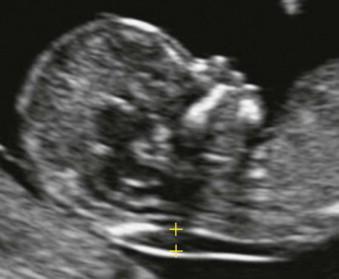
Several prospective interventional studies in hundreds of thousands of pregnancies, have demonstrated that firstly, the risk of chromosomal abnormalities increases with both maternal age and fetal NT thickness, and secondly, in pregnancies with low fetal NT the maternal age-related risk is decreased. For a 5% false-positive rate, fetal NT screening identifies 75–80% of fetuses with trisomy 21 and other major aneuploidies.
There is no significant association between fetal NT and maternal serum free β-hCG or PAPP-A in either trisomy 21 or euploid pregnancies and therefore the ultrasononographic and biochemical markers can be combined to provide more effective screening than either method individually. Several prospective interventional studies have demonstrated that for a 5% false-positive rate the first-trimester combined test identifies about 90% of trisomy 21 pregnancies.
One option in first-trimester combined screening for trisomy 21 is to perform biochemical and ultrasonographic testing as well as to counsel women in one-stop clinics for assessment of risk (OSCAR). This has been made possible by the introduction of biochemical analyzers which provide results within 30 minutes of obtaining a blood sample. The ideal gestation for OSCAR is 12 weeks because the aim of the first-trimester scan is not just to screen for trisomy 21 but also to diagnose an increasing number of fetal malformations, and in this respect the ability to visualize fetal anatomy is best at 12 weeks. An alternative strategy for first-trimester combined screening is for biochemical testing and ultrasound scanning to be carried out in two separate visits, with the first done at 9–10 weeks and the second at 12 weeks. It has been estimated that this approach would improve the detection rate from 90% to 93–94%. The potential advantage of two-stage screening in terms of detection rate may be eroded by the likely increased non-compliance with the additional steps.
Three mathematical models have been proposed for the additional use of second-trimester biochemical testing with the aim of improving first-trimester combined screening. Firstly, the integrated test in which all patients have first-trimester NT and PAPP-A tests and second-trimester AFP, uE3, free β-hCG and inhibin A tests, with the combined results given on completion of the process so that high-risk patients can be identified for second-trimester amniocentesis. Secondly, step-wise sequential screening, in which all patients are tested for first-trimester NT, serum PAPP-A and free β-hCG, and high-risk patients are offered CVS, whereas low- or intermediate-risk patients have second-trimester AFP, uE3, free β-hCG and inhibin and A tests, if the combined risk from first- and second-trimester testing becomes high, the patients have second-trimester amniocentesis. Thirdly, contingent screening, which is similar to step-wise sequential screening but second-trimester biochemical testing is performed only in those with an intermediate risk after first-trimester screening.
The estimated performance of the three approaches is similar with a detection rate of 90–94% at a false-positive rate of 5%. The advantages of the contingent approach are that firstly, second trimester testing is avoided in 75–80% of patients and secondly, the diagnosis of about 60% of fetuses with aneuploidies is made in the first trimester.
The disadvantages of this across-trimesters approach to screening are firstly, the performance of screening is poorer than with an integrated first-trimester approach incorporating the new sonographic markers; secondly, reassurance of parents with a low-risk result is delayed by several weeks; thirdly, many women with an affected pregnancy are deprived of the option of safer first-trimester termination of pregnancy; and fourthly, many women who do not complete the two-stage test are essentially deprived of screening.
A beneficial consequence of screening for trisomy 21 is the early diagnosis of trisomies 18 and 13, which are the second and third most common chromosomal abnormalities. At 11–13 weeks, the relative prevalence of trisomies 18 and 13 to trisomy 21 are one to three and one to seven, respectively. All three trisomies are associated with increased maternal age, increased fetal NT and decreased maternal serum PAPP-A, but in trisomy 21 serum free β-hCG is increased whereas in trisomies 18 and 13 this is decreased. In addition, trisomy 13, unlike trisomies 21 and 18, is associated with fetal tachycardia, with the heart rate being above the 95th centile of euploid fetuses in 85% of fetuses with trisomy 13.
Use of the algorithm for trisomy 21 identifies about 75% of fetuses with trisomies 18 and 13. The combined use of the algorithm for trisomy 21 with specific algorithms for trisomies 18 and 13 improves the detection of these aneuploidies to 95% with a small increase in false-positive rate by about 0.1%. Another beneficial consequence of the use of the combined three algorithms is the early identification of about 85% of fetuses with triploidy.
In twin pregnancies effective screening for chromosomal abnormalities is provided by a combination of maternal age and fetal NT thickness. The performance of screening can be improved by the addition of maternal serum biochemistry but appropriate adjustments are needed for chorionicity. In dichorionic twins at 11–13 weeks, the levels of maternal serum free β-hCG and PAPP-A are about twice as high as in singleton pregnancies, but in monochorionic twins the levels are lower than in dichorionic twins.
Chorionicity can be determined by examining the junction of the inter-twin membrane with the placenta ( Figure 2-2 ). In dichorionic twins there is extension of the placenta into the base of the membrane (lambda sign), which is absent in monochorionic twins.
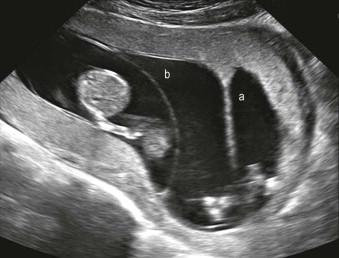
In dichorionic twins, patient-specific risks for trisomy 21 are calculated for each fetus based on maternal age and fetal NT, and the detection rate (75–80%) and false-positive rate (5% per fetus or 10% per pregnancy) are similar to those in singleton pregnancies. First-trimester screening allows the possibility of earlier and therefore safer selective fetocide in cases where one fetus is euploid and the other is abnormal. An important advantage of screening by fetal NT is that when there is discordance for a chromosomal abnormality, the presence of a sonographically detectable marker helps to ensure the correct identification of the abnormal twin should the parents choose selective termination.
In monochorionic twin pregnancies the false-positive rate of NT screening is higher than in dichorionic twins, because increased NT in at least one of the fetuses is an early manifestation of twin-to-twin-transfusion syndrome, as well as a marker of chromosomal abnormalities. In the calculation of risk of trisomy 21 the NT of both fetuses should be measured and the average of the two should be considered.
In addition to NT, other highly sensitive and specific first-trimester sonographic markers of trisomy 21 are absence of the nasal bone, increased impedance to flow in the ductus venosus and tricuspid regurgitation ( Table 2-6 ). Absence of the nasal bone, reversed a-wave in the ductus venosus and tricuspid regurgitation are observed in about 60%, 66% and 55% of fetuses with trisomy 21 and in 2.5%, 3.0% and 1.0%, respectively, of euploid fetuses. Absence of the nasal bone, abnormal flow in the ductus venosus and tricuspid regurgitation are observed in about 50%, 55% and 30%, respectively, of fetuses with trisomies 18 and 13.
| Euploid | Trisomy 21 | Trisomy 18 | Trisomy 13 | |
|---|---|---|---|---|
| Nuchal translucency in mm, median | 2.0 | 3.4 | 5.5 | 4.0 |
| Absent nasal bone, % | 2.5 | 60 | 53 | 45 |
| Tricuspid regurgitation, % | 1.0 | 55 | 33 | 30 |
| Ductus venosus reversed a-wave, % | 3.0 | 66 | 58 | 55 |
The fetal nasal bone at 11–13 weeks' gestation is classified as present or absent. For examination of the nasal bone, the image should be magnified so that the head and the upper thorax only are included on the screen and a mid-sagittal view of the fetal profile should be obtained. The ultrasound transducer must be placed parallel to the direction of the nose and the probe then gently tilted from one side to the other of the fetal nose. When these criteria are satisfied, three distinct lines are seen at the level of the fetal nose ( Figure 2-1 ). The first two, which are proximal to the forehead, are horizontal and parallel to each other, resembling an ‘equals sign’. The top line represents the skin and the bottom one, which is thicker and more echogenic than the overlying skin, represents the nasal bone. A third line, almost in continuity with the skin but at a higher level, represents the tip of the nose. The nasal bone is considered to be present if it is more echogenic than the overlying skin and absent if either it is not visible or its echogenicity is the same or less than that of the skin ( Figure 2-3 ).
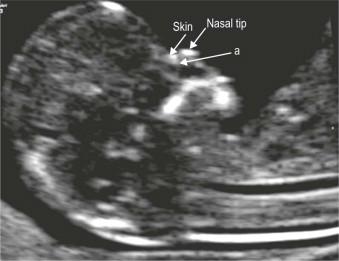
In the assessment of ductus venosus studies the following criteria should be fulfilled. The examinations must be undertaken during fetal quiescence, the magnification of the image should be such that the fetal thorax and abdomen occupy the whole screen, a right ventral mid-sagittal view of the fetal trunk must be obtained and colour flow mapping used to demonstrate the umbilical vein, ductus venosus and fetal heart ( Figure 2-4 ). The pulsed Doppler sample must be small (0.5–1.0 mm) to avoid contamination from the adjacent veins and it should be placed in the yellowish aliasing area which is the portion immediately above the umbilical sinus. The insonation angle must be less than 30 degrees, the filter should be set at a low frequency (50–70 Hz) to allow visualization of the whole waveform and the sweep speed must be high (2–3 cm/s) so that the waveforms are widely spread.
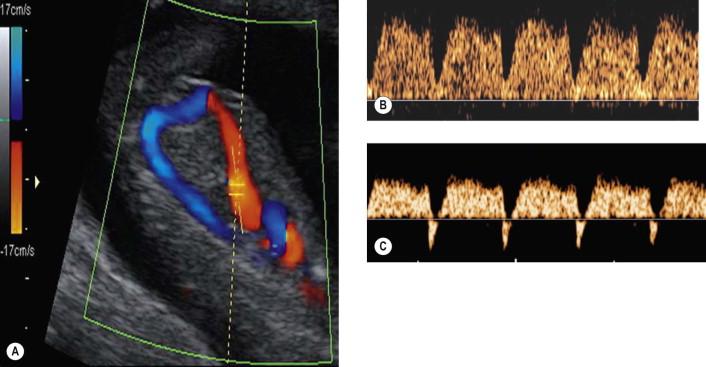
Ductus venosus waveforms are classified as normal, when the a-wave observed during atrial contraction is positive, or abnormal, when the a-wave is absent or reversed ( Figure 2-4 ). The preferred alternative in the estimation of patient-specific risks for pregnancy complications is measurement of the pulsatility index for veins (PIV) as a continuous variable. This can be measured by the machine after manual tracing of the outline of the waveform.
In the assessment of flow across the tricuspid valve the magnification of the image should be such that the fetal thorax occupies most of the image. An apical four-chamber view of the fetal heart should be obtained ( Figure 2-5 ). A pulsed-wave Doppler sample volume of 2.0 to 3.0 mm should be positioned across the tricuspid valve so that the angle to the direction of flow is less than 30 degrees from the direction of the inter-ventricular septum. Tricuspid regurgitation is diagnosed if it is found during at least half of the systole and with a velocity of over 60 cm/s, since aortic or pulmonary arterial blood flow at this gestation can produce a maximum velocity of 50 cm/s ( Figure 2-5 ). The sweep speed should be high (2–3 cm/s) so that the waveforms are widely spread for better assessment. The tricuspid valve could be insufficient in one or more of its three cusps, and therefore the sample volume should be placed across the valve at least three times, in an attempt to interrogate the complete valve.
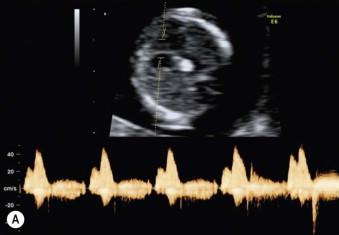
In the assessment of hepatic artery flow the following criteria should be fulfilled. The examinations must be undertaken during fetal quiescence and the magnification of the image should be such that the fetal thorax and abdomen occupy the whole screen. A right ventral mid-sagittal view of the fetal trunk must be obtained and colour flow mapping used to demonstrate the umbilical vein, ductus venosus, descending aorta and hepatic artery ( Figure 2-6 ). The pulsed Doppler sample should be set at 2.0 mm and placed so that it includes both the ductus venosus and adjacent upper part of the hepatic artery (to ensure that this vessel rather than the coeliac trunk is sampled). The sample should then be reduced to 1.0 mm to include only the hepatic artery. The insonation angle to the hepatic artery must be less than 30 degrees, the filter set at a high frequency (120 Hz) to avoid contamination from adjacent veins, the sweep speed must be high (2–3 cm/s) so that the waveforms are widely spread and the pulsed wave pulse repetition frequency should be low (2.2–3.3 Hz) allowing better assessment of the peak systolic velocity (PSV). When three similar consecutive waveforms are obtained, the PSV should be measured by the software of the machine after manual tracing.
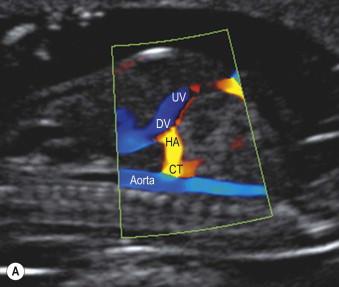
In trisomy 21 PSV is increased and it is above the 95th percentile of the normal range (15 cm/s) in about 70% of affected fetuses.
Assessment of each of these ultrasound markers can be incorporated into first-trimester combined screening by maternal age, fetal NT and serum free β-hCG and PAPP-A resulting in improvement of the performance of screening with an increase in detection rate to 93–96% and a decrease in false-positive rate to less than 3.0%. A similar performance of screening can be achieved by a contingent policy in which first-stage screening by maternal age, fetal NT and serum free β-hCG and PAPP-A is offered to all cases. Patients with a risk of 1 in 50 or more are considered to be screen-positive and those with a risk of less than 1 in 1000 are screen-negative. Patients with the intermediate risk of 1 in 51 to 1 in 1000, which constitutes about 15% of the total population, have second-stage screening of either nasal bone, ductus venosus or tricuspid blood flow which modifies their first-stage risk. If the adjusted risk is 1 in 100 or more, the patients are considered to be screen-positive and those with a risk of less than 1 in 100 are screen-negative.
At 11–13 weeks certain easily detectable defects are strongly associated with certain specific aneuploidies. The diagnosis of alobar holoprosencephaly is based on the fusion of the anterior horns of the lateral ventricles and the absence of the butterfly sign in a cross-sectional view of the fetal brain ( Figure 2-7 ). Exomphalos is diagnosed if there is herniation of bowel or liver into the base of the umbilical cord and if the CRL is 45 mm or more ( Figure 2-8 ). Megacystis is defined as enlarged bladder with a longitudinal measurement > 7 mm of 7 mm or more ( Figure 2-9 ).
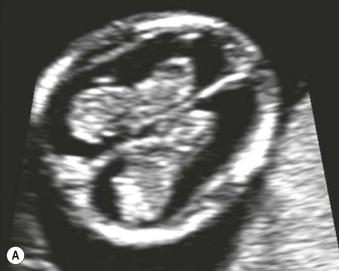
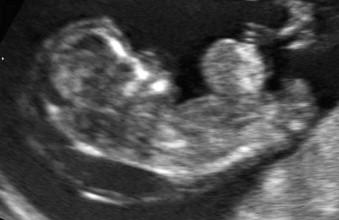
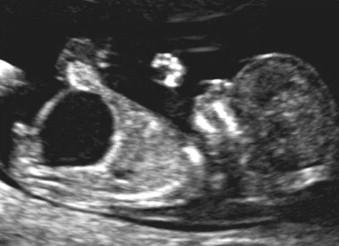
In holoprosencephaly the risk for trisomy 13 is 1 : 2, in diaphragmatic hernia the risk for trisomy 18 is 1 : 4, in exomphalos the risk for trisomy 18 is 1 : 4 and for trisomy 13 is 1 : 10, in megacystis the risk for either trisomy 18 or 13 is 1 : 10 and in atrioventricular septal defect the risk for trisomy 21 is 1 : 2.
In the second-trimester scan each chromosomal defect has its own syndromal pattern of detectable abnormalities.
Become a Clinical Tree membership for Full access and enjoy Unlimited articles
If you are a member. Log in here